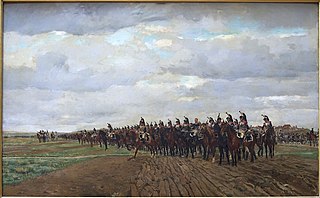 W
W1805, Cuirassiers Before the Charge, also known as Cuirassiers of 1805, before battle or 1805, is an 1878 painting by Ernest Meissonier depicting a line of Napoleonic cuirassiers before making a cavalry charge. It is currently on display at the Musée Condé.
 W
WThe Assassination of the Duke of Guise is a painting by Paul Delaroche. It was commissioned in 1833 by Ferdinand-Philippe d'Orléans and delivered in May 1834. It shows Henry I, Duke of Guise's assassination by Henry III's royal guard on 23 December 1588. It is now in the Musée Condé in Chantilly, whilst a replica hangs in the Château de Blois. Another replica was made for the 2014 exhibition L'invention du passé. Histoires de cœur et d'épée en Europe, 1802-1850. at the Musée des beaux-arts de Lyon.
 W
WThe Chord — alternatively known as The Serenader and Mezzetino — is an oil on panel painting of c. 1715 in the Musée Condé, Chantilly, by the French Rococo painter Antoine Watteau. At 24 by 17 cm, the painting forms a single-figure full-length composition that depicts a guitarist in theatrical costume, sitting amid the landscape; the guitarist's figure, based on a red and black chalk drawing owned by the Louvre, was also used in two other paintings by Watteau, The Surprise and Pleasures of Love.
 W
WLe Concert Champêtre is an 1857 painting by French artist Jean-Baptiste-Camille Corot, now in the Musée Condé of Chantilly, France. A reworking of a composition exhibited by Corot in the Salon of 1844, the painting was shown in the Salon of 1857.
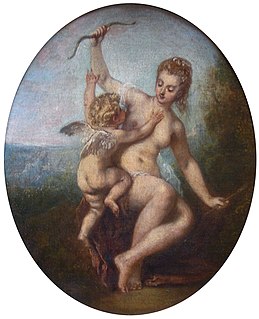 W
WCupid Disarmed is a c. 1715 painting, usually but not definitively attributed to Antoine Watteau. It is one of eight paintings kept by Watteau's friend and protector Jean de Jullienne until the latter's death in 1766. Benoît Audran engraved it in 1727 and described and reproduced it in an inventory of the Jullienne collection in 1756. After Jullienne's death the art dealer Boileau bought it for Jean-Baptiste de Montullé, Jullienne's executor.
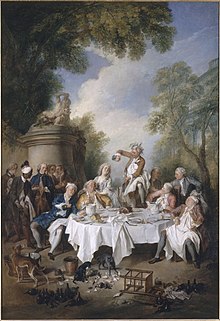 W
WThe Ham Dinner is a 1735 painting by Nicolas Lancret(22 January 1690 – 14 September 1743), a French painter who was born and died in Paris.
 W
WThe Sickness of Antiochus or Stratonice and Antiochus is an 1840 painting by the French artist Jean Auguste Dominique Ingres. It is now in the Musée Condé in Chantilly.
 W
WLandscape with Two Nymphs is a c.1659 painting by Nicolas Poussin. A late work, it seems to have been painted for Charles Le Brun, another painter. It was sold from the Radziwiłł collection in 1866 to Frédéric Reiset, a curator at the Louvre. Reiset sold it with the rest of his collection to Henri d'Orleans, Duke of Aumale in 1879 and so the work is now in the Musée Condé in Chantilly
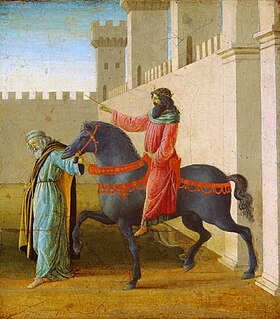 W
WLife of Esther or Scenes from the Story of Esther is the title of a series of six panel paintings by Sandro Botticelli and Filippino Lippi, showing scenes from the story of Esther and produced in the 1470s. They originally decorated the sides of a pair of cassoni or marriage chests, the two long panels on the fronts, and the smaller ones on the ends. They are now split between five museums in Europe and Canada.
 W
WThe Madonna of Loreto is a painting finished around 1511 by the Italian High Renaissance painter Raphael. It is housed in the Musée Condé of Chantilly, France.
 W
WThe Massacre of the Innocents is a 1625-1632 painting by Nicolas Poussin, showing the Massacre of the Innocents. It was probably commissioned by the Roman collector Vincenzo Giustiniani, probably in memory of the tragic fate of the Giustiniani children taken hostage by the Ottoman Empire in 1564. It remained in the Palazzo Giustiniani until 1804, when it was bought by Lucien Bonaparte. It then passed through several other hands before being bought in London by Henri d'Orleans, Duke of Aumale. It is now in the Musée Condé in Chantilly, France.
 W
WThe Mystic Marriage of St. Francis is a painting by the Italian Renaissance artist Sassetta, now in the Musée Condé of Chantilly, France.
 W
WThe Orléans Madonna is a c.1506-1507 painting of the Madonna and Child by Raphael. It was acquired by Philippe II, Duke of Orléans for the Orléans collection, giving it its present name. It is now in the Musée Condé in Chantilly.
 W
WThe Oyster Dinner is a 1735 painting by Jean-François de Troy. It and Nicolas Lancret's The Ham Dinner were commissioned by Louis XV to decorate the dining room in the lesser apartments at the Palace of Versailles. It includes the first appearance of a champagne bottle in painting. Both paintings are now in the Musée Condé.
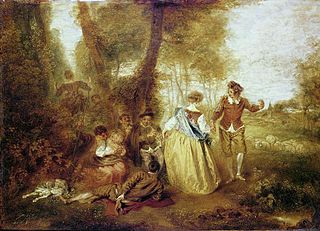 W
WPastoral Pleasure is a c.1714–1716 fête galante painting by Jean Antoine Watteau, now in the musée Condé in Chantilly. Two other Watteau paintings survive with extremely similar compositions - the largest and most finished is The Shepherds, whilst another seems to be a reworking of the Charlottenburg painting. Pierre Rosenberg argues that the Chantilly version was an oil sketch for the Charlottenburg work. Three other copies of the Chantilly version appeared in 19th and 20th century auctions, but their locations are now unknown.
 W
WPortrait of a Woman is an oil on canvas portrait of an unknown woman, now attributed to Dosso Dossi, painted around 1530-1535. It is now in the Musée Condé.
 W
WPortrait of Gaston, Duke of Orléans is an oil on canvas portrait of Gaston, Duke of Orléans by Anthony van Dyck, painted in 1632 or 1634. At the time its subject had fled France and was living in exile in his mother Marie de Medici's court in Brussels. Already official painter to Charles I of England, Van Dyck passed through the city in March 1632 - a document shows that in August 1632 Charles I paid van Dyck for a full length painting of "his brother-in-law, Monsieur, the brother of the king of France". However, the painting has alternatively been dated to 1634, the date given in a later inscription added to the painting - that year van Dyck was again in the Spanish Netherlands.
 W
WPortrait of Simonetta Vespucci is an oil on canvas painting by the Italian Renaissance painter Piero di Cosimo, dating from about 1480 or 1490. It is in the Musée Condé in Chantilly, France.
 W
WSleeping Venus is a c. 1603 painting by Annibale Carracci held by the Musée Condé in Chantilly, Oise, France. This oil painting measures 190x328cm. It depicts Venus sleeping with her arm above her head as putti frolic around her. Carracci painted Sleeping Venus for Odoardo Farnese. Giovanni Battista Agucchi wrote an ekphrasis of this painting that Carlo Cesare Malvasia included in his book Life of the Carracci. In The Lives of the Modern Painters, Sculptors and Architects, Giovanni Pietro Bellori wrote a description of the painting that paraphrases Agucchi's ekphrasis without citation.
 W
WTheseus Rediscovering His Father's Sword is a c.1638 painting by Nicolas Poussin and Jean Le Maire, acquired in London by Henri d'Orléans, Duke of Aumale in 1860, moved to his château de Chantilly in 1871 and now in the Musée Condé at Chantilly. The Uffizi and the Wildenstein collection hold autograph copies of the work, but X-ray examination has shown much retouching of the Chantilly version and so it is accepted as the original of the composition.
 W
WThe Three Graces is an oil painting by Italian painter Raphael, housed in the Musée Condé of Chantilly, France. The date of origin has not been positively determined, though it seems to have been painted at some point after his arrival to study with Pietro Perugino in about 1500, possibly 1503-1505. According to James Patrick in 2007's Renaissance and Reformation, the painting represents the first time that Raphael had depicted the nude female form in front and back views.
 W
WThe Two Foscari is an 1855 painting by Eugène Delacroix, now in the Musée Condé in Chantilly.
 W
WVenus Anadyomene is a painting by the French painter Jean-Auguste-Dominique Ingres. It is now held at the Musée Condé, Chantilly, France. It is a female nude of the Venus Anadyomene type, showing the goddess Venus rising from the sea.
 W
WThe Villa La Pelucca frescoes are a 1520-1523 cycle of frescos by Bernardino Luini, commissioned by the Milanese nobleman Gerolamo Rabia for his villa near Monza, known as 'La Pelucca'. Most of the surviving fragments are in the Pinacoteca di Brera in Milan, though others are in the Wallace Collection in London, the Louvre in Paris, the Musée Condé in Chantilly and other private collections. Stylistically they shown the influence of Bramantino - Women Bathing the figure's shoulders is a homage to the Trivulzio Tapestries, particularly February from that cycle.
 W
WVirgin of Mercy is a painting of the Virgin of Mercy type, produced around 1452 for the Cadard family by Enguerrand Quarton and Pierre Vilatte. It is now in the Musée Condé in Chantilly.
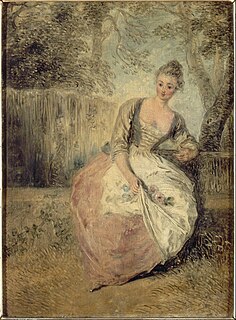 W
WThe Worried Lover is a c. 1715-1717 painting by Jean-Antoine Watteau. A preparatory drawing now entitled Two studies of a seated woman exactly matches the pose of the woman in the painting. Watteau also made an etching showing a woman seated in a very similar pose. Single figures were common in his work and also appear in La Finette, L'Indifférent and The Dreamer. According to Jean Ferré, the cut roses in the painting are a symbol of "consumed love".